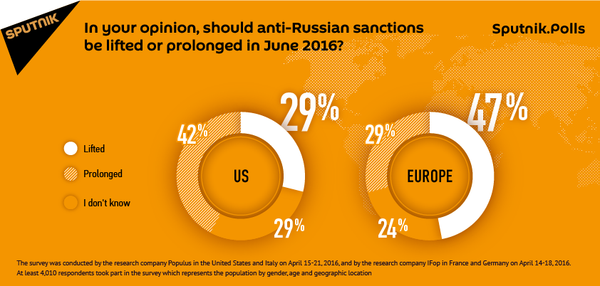However, this changed in March 2014. Following a legal referendum, the parliament of Crimea declared the region's independence from Ukraine, and formally applied to become part of Russia. Spun as an illegal "annexation" by Western politicians and media, US leaders used the event as a pretext for the imposition of sanctions on Russian individuals, assets and entities.
Asset freezes and visa bans were applied to hundreds of individuals, while many Russian businesses had their assets frozen in the EU and US. Imports from Crimea and Sevastopol to the EU were banned outright, as was investment into the region. Europeans and EU-based companies are also banned from purchasing real estate or entities there, financing Crimean companies or supplying related services.
Other economic sanctions included a ban on EU nationals and companies buying or selling new bonds, equities or similar financial instruments issued by major Russian banks, energy companies, defense firms and their subsidiaries, outside the EU, three major Russian energy companies and three Russian defense companies. The European Investment Bank likewise suspended the signing of new financing operations in Russia.
Arguably underlining the highly politicized nature of the sanctions, the EU was careful to exempt oil and gas from sanctions — after all, the vast majority of EU member states are heavily dependent on Russian supplies.
Russian President Vladimir Putin did not take the groundless assault lying down. In August 2014, he signed an edict banning the import of agricultural products, raw materials and food from all countries that had imposed sanctions on Russian entities or individuals — Australia, Canada, the EU, Norway and the US. In 2015, the embargo was expanded to include products originating in Albania, Iceland, Liechtenstein and Montenegro.
As 73 percent of the prohibited imports flowed from the EU, it was inevitably going to be the most heavily impacted target of the countersanction program — and EU goods exports to Russia duly fell by as much as 14.5 percent.
The impact of this decline in trade has proven difficult to accurately determine, although the Vienna Institute for International Economic Studies estimates EU the losses could amount to as much US$63.2 billion (€55 billion). In all, the EU itself estimates its overall GDP has contracted by at least —0.4 percent every year since the imposition of the sanctions — a figure that could rise to around one percent if the sanctions persist.
The losses don't stop there — Russian countersanctions have produced a myriad of deleterious effects in other areas.
Annually, the Institute of Economic Forecasting at the Russian Academy of Sciences suggests European financial institutions have suffered losses of between US$8-10 billion from reductions in interest payments, and reduced economic cooperation as well as a ban on supplies of dual-use technologies have cost the EU around US$10-15 billion.
Nonetheless, the countersanctions' impact has not been evenly distributed across the bloc — Eastern Europe, particularly the Baltic states and Finland, have been among the most badly affected, with some countries' GDP falling by up to one percent as a result.

However, Germany, as the biggest exporter to Russia, has been the most affected — some commentators attributed the country's major economic wobble in 2014 to the countersanctions. It is perhaps unsurprising then German lawmakers and heads of business responded angrily to suggestions in June that the US might extend and expand its own sanctions program.
Moreover, Russia has been able to mitigate the impact of these sanctions by turning away from the US towards new, alternative economic partners, particularly emerging markets that refused to go along with the US' punitive measures.
China in particular has proven an enthusiastic partner — by October 2014 alone, the two countries had completed approximately 40 agreements related to finance and technology.
Likewise, food exports from Brazil and other Latin American countries have fully compensated for losses caused by US restrictions. As a result, when the sanctions end, Russia may have no need to reignite the relationships severed by US-led actions.
Putin's historic meeting with US President Donald Trump at the July 2017 G20 Summit was productive in many areas, and arguably signal the US-led sanctions program is finally nearing its end. For many European countries, that day evidently can't come soon enough.





